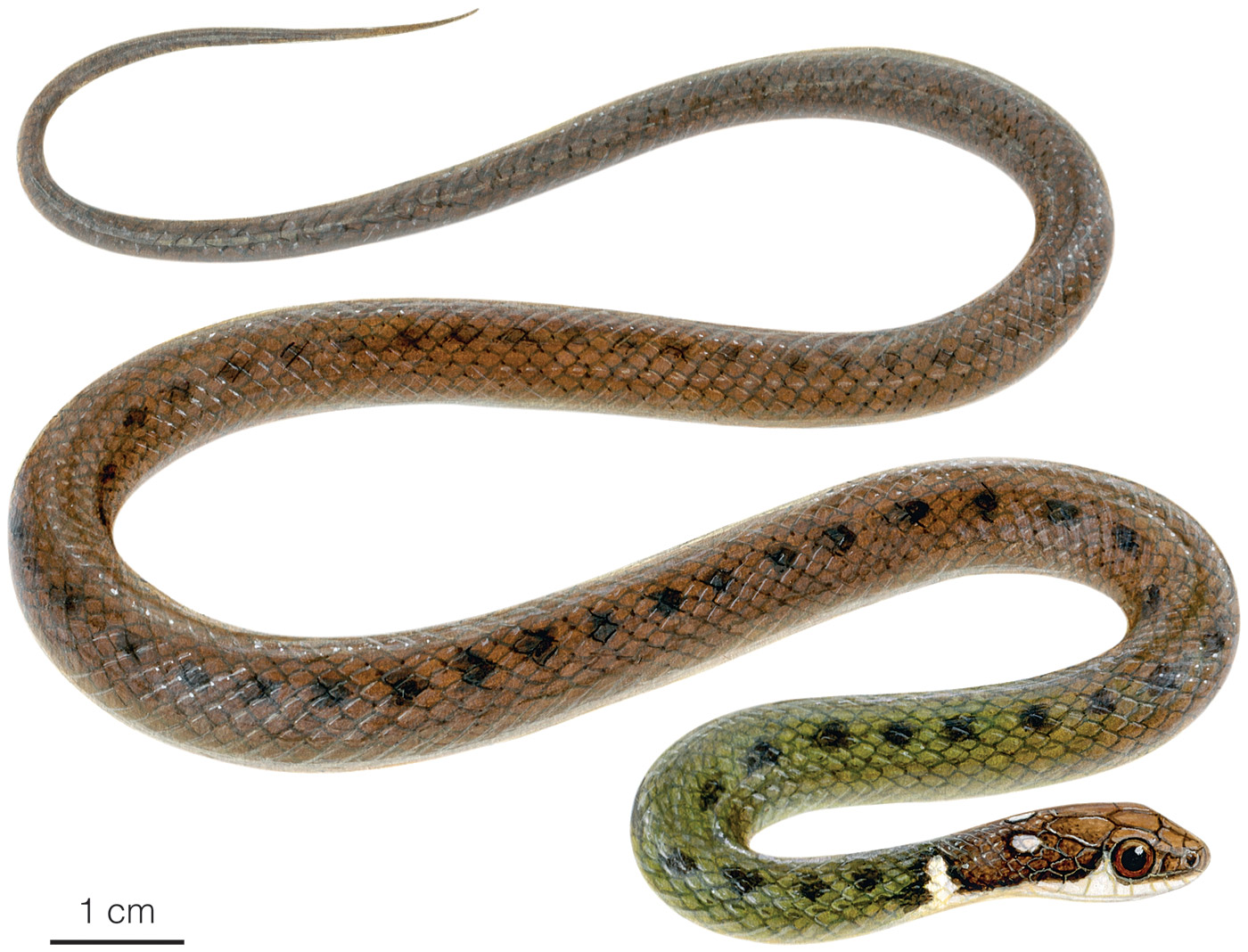Published May 1, 2024. Open access. | Purchase book ❯ |
Ivory-naped Snake (Eutrachelophis bassleri)
Reptiles of Ecuador | Serpentes | Colubridae | Eutrachelophis bassleri
English common name: Ivory-naped Snake.
Spanish common name: Culebra cuello de marfil.
Recognition: ♂♂ 37.7 cmMaximum distance from the snout to the tip of the tail. Snout–vent length=26.7 cm. ♀♀ 36.9 cmMaximum distance from the snout to the tip of the tail. Snout–vent length=26.9 cm..1 Eutrachelophis bassleri is a small snake that can be recognized by having smooth dorsals arranged in 15 rows at mid-body and a unique nape coloration (Fig. 1). The dorsal aspect of the neck is dark brown with an incomplete white collar, two paired ocelli, and a postocular wedge of pale color extending dorsally from the lip.1,2 The body exhibits a transition from dark green to brown from the head to the tail, with prominent dark spots along the sides that gradually fade posteriorly. The underside is white anteriorly and turns yellow as it approaches the first third of the belly.1,2 No other snake in Amazonian Ecuador has a similar coloration.

Figure 1: Illustration of an adult male of Eutrachelophis bassleri based on photographs of a Peruvian specimen.
Natural history: Eutrachelophis bassleri is an extremely rare diurnal snake that occurs in the leaf-litter of pristine lowland rainforests.1,2 Nothing else is known about the ecology of this species, but other members of the genus have been found hidden under the leaf-litter during the day.3
Conservation: Data Deficient There is inadequate information to make an assessment of extinction risk.. Eutrachelophis bassleri is a recently described species. Therefore, its conservation status has not yet undergone a formal evaluation by the IUCN. Here, it is proposed to be included in the DD category because there is inadequate information to make an assessment of its extinction risk based on its scarce distribution and natural history data. The species is known from just two localities in Ecuador and eight in Perú.4 These localities are separated from each other by areas having adequate forest cover, suggesting it might be present elsewhere. The fact that E. bassleri has only been spotted twice in the comparatively well-sampled Ecuadorian Amazon probably indicates naturally low population densities rather than a sampling bias.
Distribution: Eutrachelophis bassleri occurs in the western Amazon basin of Ecuador (Fig. 2) and Peru, where it has been recorded in a total of 10 localities.

Figure 2: Distribution of Eutrachelophis bassleri in Ecuador. See Appendix 1 for a complete list of the presence localities included in the map.
Etymology: The genus name Eutrachelophis comes from the Greek prefix eu- (=beautiful) + trachelos (=neck) + ophis (=serpent).1 The specific epithet bassleri honors Harvey Bassler (1883–1950), a former Research Associate in the American Museum’s Department of Herpetology. Bassler collected 5 of the 12 known specimens of this rare species during a decade exploring the Amazon rainforest of Perú.1
See it in the wild: Eutrachelophis bassleri has only been recorded two times in Ecuador. Collector Ramón Olalla found one in 1948 and another one in 1962. This makes E. bassleri the second rarest snake species in the Ecuadorian Amazon. Finding additional specimens may only be possible through decade-long surveys of leaf-litter fauna along the Río Bobonaza.
Author: Alejandro ArteagaaAffiliation: Fundación Khamai, Reserva Arlequín, Ecoruta Paseo del Quinde km 56, Santa Rosa de Mindo, Pichincha 171202, Ecuador.
Illustrator: Matt Patterson.
How to cite? Arteaga A (2024) Ivory-naped Snake (Eutrachelophis bassleri). In: Arteaga A, Bustamante L, Vieira J (Eds) Reptiles of Ecuador: Life in the middle of the world. Available from: www.reptilesofecuador.com. DOI: 10.47051/HXYL8108
Literature cited:
- Myers CW, McDowell SB (1986) New taxa and cryptic species of Neotropical snakes (Xenodontinae), with commentary on hemipenes as generic and specific characters. Bulletin of the American Museum of Natural History 385: 1–112.
- Echevarría LY, Venegas JV (2015) Eutrachelophis bassleri: coloration and photographs in life. Herpetological Review 46: 449.
- Moraes LJCL, Entiauspe-Neto OM, de Fraga R, Fernandes IY, Werneck FP (2021) Systematics of the rare Amazonian genus Eutrachelophis (Serpentes: Dipsadidae), with an emended diagnosis for Eutrachelophis papilio. Zoologischer Anzeiger 295: 191–204. DOI: 10.1016/j.jcz.2021.10.003
- Zaher H, Prudente ALC (2019) The enigmatic Amazonian genus Eutrachelophis: morphological evidence and description of new taxa (Serpentes: Dipsadidae: Xenodontini). Amphibia-Reptilia 41: 215-231.
Appendix 1: Locality data used to create the distribution map of Eutrachelophis bassleri in Ecuador (Fig. 2). Go to the section on symbols and abbreviations for a list of acronyms used.
| Country | Province | Locality | Source |
| Ecuador | Pastaza | Boca del Río Pucayacu | Myers & McDowell 2014 |
| Ecuador | Pastaza | Sarayacu | Myers & McDowell 2014 |